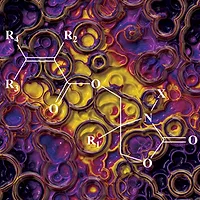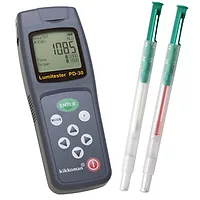Improving ATP Monitoring Technology for Food Safety Surface Sanitation Applications

Implementing and maintaining a validated sanitation program is an essential component of food safety. It is equally important to regularly verify that the cleaning processes that you are using are being correctly implemented and remain effective. Adenosine triphosphate (ATP) hygiene monitoring tests are one of the most commonly used to verify cleaning effectiveness as they are simple and easy to use and provide immediate results. Most food processing facilities in every category use ATP tests for sanitation verification and experts estimate that more than 50 million tests are conducted every year worldwide.
The method of action of conventional ATP tests involves the reaction of ATP with firefly luciferin (the biochemical that allows a firefly to light) which, in the presence of the enzyme luciferase, reacts with ATP to produce light. The amount of light produced is proportional to the amount of ATP in a sample and this ATP is quantified by measuring the light produced through this reaction using a luminometer, producing the commonly known test result in Relative Light Units (RLUs).
Processors have frequently expressed concern about the sensitivity of the tests they are using as they too often get low readings when they test. This phenomenon may be explained by the nature of the ATP molecule itself. Through exposure to heat, pH and other factors in the environment, ATP can rapidly degrade to adenosine diphosphate (ADP) and adenosine monophosphate (AMP). The presence of these molecules still indicate that surface contamination has been missed by cleaning but, since conventional ATP tests can only detect ATP and not these degradation products, contamination will not be detected.
It can be shown, however that even though the ATP in a sample degrades, the total adenylate concentration (i.e., the total concentration of ATP+ADP+AMP) is maintained. A test that can detect total adenylate (or “A3”) will provide higher sensitivity due to an increase in signal to be detected, would be less likely to produce false negative results, and would provide for an overall more accurate verification of sanitation.
With this problem in mind, and using advanced enzyme biochemistry, Kikkoman Biochemifa Company has developed an advanced ATP hygiene monitoring test that detects this total concentration of A3. Incorporating two additional enzymatic reactions (pyruvate orthophosphate dikinase to convert AMP to ATP and pyruvate kinase to convert ADP to ATP) into the test reagents, the test can detect and quantify A3 concentration and the level of detection and sensitivity of the ATP test can be dramatically increased.
During an independent evaluation completed by a leading food safety laboratory, this detection of ATP, ADP and AMP was verified. Separate solutions of ATP, ADP and AMP were prepared and the A3 test detected ATP, ADP and AMP at very low concentrations. Conventional ATP products were not able to detect either ADP or AMP from the surface samples.
Food Samples
 Also, in this evaluation, the A3 technology was assessed side-by-side with three leading conventional ATP tests for their ability to detect adenosine nucleotides from different types of food. More than 10 different food types were tested, including beef, sausage, ready-to-eat turkey, various seafoods, eggs, beer, nuts, fruits and vegetables. In this article, we will present the data from several of these tests, including results from testing ready-to-eat turkey, raw beef, peanuts and Cantaloupe.
Also, in this evaluation, the A3 technology was assessed side-by-side with three leading conventional ATP tests for their ability to detect adenosine nucleotides from different types of food. More than 10 different food types were tested, including beef, sausage, ready-to-eat turkey, various seafoods, eggs, beer, nuts, fruits and vegetables. In this article, we will present the data from several of these tests, including results from testing ready-to-eat turkey, raw beef, peanuts and Cantaloupe.
Looking for quick answers on food safety topics?
Try Ask FSM, our new smart AI search tool.
Ask FSM →
Portions (10 g) of each solid food matrix were mixed with 90 ml of sterile distilled water and homogenized for 2 min in a masticator to generate a 10-1 dilution. Liquid food samples were not diluted. Aliquots of 10 µl of each dilution were pipetted to appropriate swabs or sponges for each type of detection device and food matrix. Measurements were performed at 23 ± 1°C. The measurements were repeated 5 times and average values were obtained.
The results of these tests are shown in Figure 1. In reviewing this data, it is important to note that relatively little ATP was shown to be present in the meat and egg products, and this is an important finding to note for anyone using ATP test on these products. The level of total adenylate in the samples, however was significantly higher, as shown by the level of detection of the A3 test. Similar results were also seen with shrimp as well as with beer.
In another important food type – peanuts – a low response was seen from the conventional ATP tests yet the A3 technology showed more than two orders of magnitude higher response than the most sensitive conventional test. Many processors will recognize the RLU responses from the conventional tests as being comparable to a typical pass/fail criterion used in sanitation programs. Yet the A3 technology shows that there is still a considerable amount of product residue remaining in the samples. This is an important finding, especially in products like peanuts that are common allergens and any residue left behind can contaminate a processor’s product. Moreover, using detection of total adenylate can also be shown to be a more sensitive method to detect trace amounts of surface contamination from tree nuts, such as almond, cashew, walnuts and hazelnuts.
Surface Sanitation
 The A3 technology was also compared to conventional ATP tests for verification of surface sanitation. Six stainless steel coupons were exposed to three different raw meats. The coupons were washed three times – the first wash a rinse with cold water, the second with hot water, and a third using a sponge with detergent and rinse. After each of these three wash steps, the steel coupons were tested with both the A3 technology and conventional ATP test.
The A3 technology was also compared to conventional ATP tests for verification of surface sanitation. Six stainless steel coupons were exposed to three different raw meats. The coupons were washed three times – the first wash a rinse with cold water, the second with hot water, and a third using a sponge with detergent and rinse. After each of these three wash steps, the steel coupons were tested with both the A3 technology and conventional ATP test.
The test results using a conventional ATP method are shown by the red lines in Figure 2. The first and second rinse steps with cold and hot water produced a result of less than 200 RLU. This is significant as many food processing facilities will use 200 RLU as a typical pass / fail criterion. Yet, it is intuitive that simply rinsing a stainless-steel surface exposed to raw meat with cold or hot water will not be sufficient to achieve an acceptable level of sanitation. Yet the conventional ATP tests would have indicated that the cleaning procedure would have indeed been effective.
When the tests were completed using the A3 method, neither the cold-water rinse nor the hot water rinse were shown to be adequate, producing RLU readings in the tens of thousands or thousands, respectively. A test reading of 200 RLU level was not achieved in any of the samples until after the use of detergent, sponge scrubbing and a thorough rinse. These results showed that A3 technology is a more accurate indicator to verify sanitation processes on stainless steel.
Summary
It can be demonstrated that a hygiene monitoring test could be developed based on the conventional ATP luciferase assay but with the combination of two additional enzymatic reactions to create a more sensitive test. Using this method, total adenylate concentrations are detected, providing for a significantly greater signal for detection. This detection method was also shown to be a far more sensitive method for detections of food residue and allergens than conventional ATP assays.
Mikio Bakke, Ph. D. works within Kikkoman Biochemifa Company's planning and development department located in Chiba, Japan. For more information, email mbakke@mail.kikkoman.co.jp directly, or visit https://biochemifa.kikkoman.com/e/.








